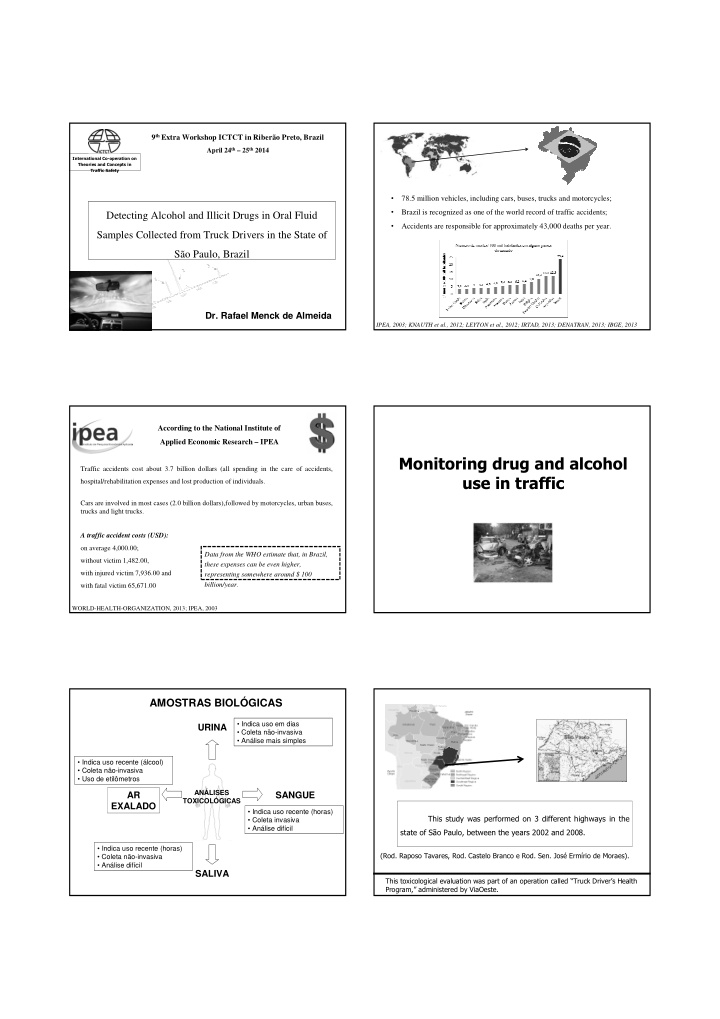



9 th Extra Workshop ICTCT in Riberão Preto, Brazil April 24 th – 25 th 2014 International Co-operation on Theories and Concepts in Traffic Safety • 78.5 million vehicles, including cars, buses, trucks and motorcycles; • Brazil is recognized as one of the world record of traffic accidents; Detecting Alcohol and Illicit Drugs in Oral Fluid • Accidents are responsible for approximately 43,000 deaths per year. Samples Collected from Truck Drivers in the State of São Paulo, Brazil Dr. Rafael Menck de Almeida IPEA, 2003; KNAUTH et al., 2012; LEYTON et al., 2012; IRTAD, 2013; DENATRAN, 2013; IBGE, 2013 According to the National Institute of Applied Economic Research – IPEA Monitoring drug and alcohol Traffic accidents cost about 3.7 billion dollars (all spending in the care of accidents, use in traffic hospital/rehabilitation expenses and lost production of individuals. Cars are involved in most cases (2.0 billion dollars),followed by motorcycles, urban buses, trucks and light trucks. A traffic accident costs (USD): on average 4,000.00; Data from the WHO estimate that, in Brazil, without victim 1,482.00, these expenses can be even higher, with injured victim 7,936.00 and representing somewhere around $ 100 billion/year. with fatal victim 65,671.00 WORLD-HEALTH-ORGANIZATION, 2013; IPEA, 2003 AMOSTRAS BIOLÓGICAS • Indica uso em dias URINA • Coleta não-invasiva • Análise mais simples • Indica uso recente (álcool) • Coleta não-invasiva • Uso de etilômetros ANÁLISES AR SANGUE TOXICOLÓGICAS EXALADO • Indica uso recente (horas) This study was performed on 3 different highways in the • Coleta invasiva • Análise difícil state of São Paulo, between the years 2002 and 2008. • Indica uso recente (horas) (Rod. Raposo Tavares, Rod. Castelo Branco e Rod. Sen. José Ermírio de Moraes). • Coleta não-invasiva • Análise difícil SALIVA This toxicological evaluation was part of an operation called “Truck Driver’s Health Program,” administered by ViaOeste.
Sample Collection and Analyses Volunteers and Procedures Truck drivers were randomly stopped and were asked by police officers to participate in research. As soon as the interview was carried out the oral fluid was collected using salivette device during the morning (9 to 11 a.m.). Determination of ethanol and drug abuse in Oral Fluid Sample Collection and Analyses Salivette NaOH 1M + 0,5mL acetic acid THC The wool + internal standard THC-d3 ethanol n-propanol HS / GC-FID + 1mL n- propanol Centrifugation 700g 10 min. Methamphetamine Oral SPME / + 2uLButyl chloroformate Fluid GC-MS +30mg de NaHCO 3 /K 2 CO 3 (2:1) + + internal standards Amphetamine Cocaine -anphetamine-d5 -methanfetamine-d5 -cocaíne-d3 About 1 minute Analyses (2002-2008): Questionnaire results All participants were male, and most were married (average and 95% confidence interval: 70.8%: 67.9–73.6%, n = 1005) Of the 1298 truck drivers stopped, 1277 agreed (98.4%) to participate and provided oral fluid samples then 1250 samples were analyzed. Then they answered the questionnaire administered by a staff member.
Questionnaire results Questionnaire results School–level educations (63.5%: 60.4–66.5%, n = 1002) The majority of the study group (77.6%: 74.3–79.6%, n = 994) reported that they had never been in traffic accidents. The ages of the drivers ranged between 18 and 80 years and the average was 39.1 years old (38.4–39.8, n = 996). Results of toxicological analyses (3.1%) Law (Alcohol, drugs and traffic) • LEI 12.760/2012 Art. 1 o Esta Lei altera dispositivos da Lei n o 9.503, de 23 de setembro de 1997, que institui o Código de Trânsito Brasileiro, com a finalidade de estabelecer alcoolemia 0 (zero) e de impor penalidades mais severas para o condutor que dirigir sob a influência do álcool (...) Art. 165. Dirigir sob a influência de álcool ou de qualquer outra substância psicoativa que determine dependência: Infração - gravíssima; Art. 276. Qualquer concentração de álcool por litro de sangue ou por litro de ar alveolar sujeita o condutor às penalidades previstas no art. 165. Parágrafo único. O Contran disciplinará as margens de tolerância quando a -18 for ethanol infração for apurada por meio de aparelho de medição, observada a -8 for amphetamine (1 for methanfetamine) legislação metrológica. -7 for cocaine -5 for THC -1 for cocaine and THC Illicit drugs Psychoactive medicines Medicines that can affect driving safety Cannabis – Are often misused by drug addicts Amphetamines Most common: sleeping agents and – Amphetamine tranquilizers/sedatives – Methamphetamine – Diazepam (Valium etc.) – MDMA (Ecstasy) – Oxazepam (Sobril etc.) – MDEA – Clonazepam (Rivotril etc.) – MDA – Bromazepam (Lexotan etc.) Cocaine – Flunitrazepam (Rohypnol etc.) Heroin – Zopiclone (Imovane etc.) Also: strong pain killers (opioids) – Codeine – Morphine – Tramadol
Conclusion UNIVERSIDADE DE SÃO PAULO Faculdade de Ciências Farmacêuticas Departamento de Análises Clínicas e Toxicológicas Laboratório de Análises Toxicológicas The finding that drug use is more common than alcohol use among truck drivers emphasizes the need for prevention, fiscalizations and educational campaigns highlighting not only the risks of using alcohol but also of abusing drugs. Despite the current Brazilian traffic code, which states that “driving under the influence of alcohol or any other psychoactive substances that cause dependence” is a serious offense, random testing and checkpoints are only performed to control alcohol use (breath testing). Therefore, a more intense and judicious surveillance of traffic regarding impaired driving is necessary to better promote safety for everyone. Dr. Rafael Menck de Almeida rafaelmenck@usp.br
Recommend
More recommend